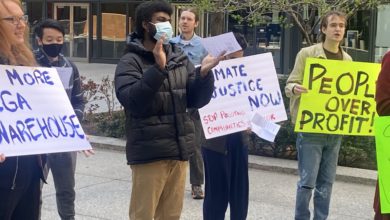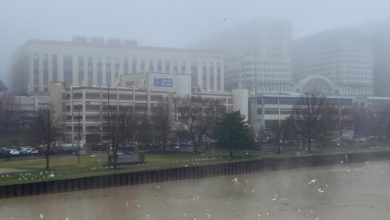A natural gas storage facility in the Aliso Canyon area of Los Angeles has been leaking methane and poisonous additives into the air since October 23, 2015, making it the longest running environmental disaster in California history.
The leak has released over 150 million tons of methane into the air. At its peak rate the leak was spewing the equivalent emissions of 7 million cars. The methane spewed from the Aliso Canyon facility accounted for a doubling in methane emissions in California last year as tens of thousands of pounds were added every day. Instruments measuring greenhouse gas emissions show a noticeable increase in methane reaching as far south as Orange County – over 40 miles from the leak. Thousands of nearby residents have been displaced after falling ill and a no-fly zone was declared over the area.
Criminal negligence at SoCal Gas
The criminal actions of SoCal Gas from the time the leak sprang have helped to endanger the local community and world climate. SoCal Gas took two weeks to notify the Air Resources Board and even went as far as turning back a volunteer pilot with Environmental Defense Fund who attempted to measure the methane leak.
Their only meaningful action to stop the leak wouldn’t begin until December when the company began drilling a relief well that still hasn’t been completed and began drawing down the quantity of gas in the well. During multiple attempts to plug the well the company actually created a massive 80 foot by 30 foot crater around the well opening, almost causing a total blowout as the well opening and encased piping nearly collapsed. From that time forward a state regulator has been on site monitoring SoCal Gas work with the compromised well suspended by wires as they drill the relief well.
SoCal Gas has generally resisted each step of the way from the declaration by Jerry Brown of a state emergency to the community demand that the entire Aliso Canyon facility be shut down. Brown only declared a state of emergency on January 6 after being publicly questioned for his conflict of interest, with his sister sitting on the board of Sempra Energy, a parent company of SoCal Gas that contributed over 100,000 to Brown’s last campaign.
But none of this nefarious behavior by SoCal Gas compares to their decision in 1979 to get rid of the sub-surface safety valves on their gas storage facilities. The decision was prompted by the fact that state law only requires the company to outfit facilities with sub-surface safety valves if they are within 100 feet of a road or park or 300 ft of a home. Lawyers engaged in lawsuits for hundreds of Porter Ranch residents against SoCal Gas have pointed out that the company, despite refusing to replace these sub-surface safety valves, told state regulators that they had.
When asked by LA Weekly why these had not been replaced a representative of SoCal Gas stated that the part was hard to find. If the sub-surface safety valve had been in place the facility could have been shut down on Oct. 23, preventing poisonous gas from getting nearby Porter Ranch residents sick with nausea, vomiting, headaches, lung damage, nosebleeds and more. With a sub-surface safety valve the displacement of thousands of Porter Ranch residents would have been avoided.
Finally, the company reported in a state regulatory filing in November 2014 that during routine work in 2008 and 2013 they had determined that there was significant corrosion of cement encasing of several of the underground facilities and attempted to convince the California Public Utilities Commission to approve rate increases to cover further inspections. But SoCal Gas is the largest gas utility in the country making hundreds of millions in revenue. The truth is the company could and should pay for its own safety upgrades but wants to put as much of the costs on the backs of working people as possible to maximize profits.
The executives of SoCal Gas, knowing all that they did and taking action on more than one occasion to disrupt, slow, and distort their responsibility for the unsafe conditions that lead to the Aliso Canyon leak should be in prison.
LA community fights back
Local environmentalists who spent the past couple years organizing in the San Fernando Valley against fracking quickly took leadership of the fight against SoCal Gas – a facility made up almost entirely of imported, fracked gas from the Midwest. Through their independent efforts to document the leak, including infrared photography depicting the massive size of the catastrophe, thousands of nuisance complaints to the South Coast Air Quality Management District, civil lawsuits, and community protests, the local people were able to force the relocation of residents and state emergency declaration.
Under the leadership of Save Porter Ranch, Food & Water Watch, and other community organizations the people of Los Angeles came out in force at a series of abatement hearings organized by the SCAQMD for the past several weeks. The abatement hearings were to determine an abatement order that would force SoCal Gas to come into compliance with air quality regulations.
Hundreds of residents and their allies attended the meetings and demanded the total shut down of the Aliso Canyon storage facility, including all 115 wells, an independent health impact study funded by SoCal Gas, a leak detection system, emergency plans in case of a leak, and much more. After three weeks of protests at the hearings and hundreds of testimonies the SCAQMD issued an order of abatement that includes the closure of only the leaking well and not the entire facility. Residents and organizers are happy with some of the elements of the abatement order, including permanent sealing of the well, independent health study, continuous air monitoring, continuous infrared monitoring until 30 days after the leak has stopped and a comprehensive leak detection system, but are quick to point out that only the total closure of the Aliso Canyon facility can protect the environment and local community.
Unregulated, booming industry ensures future disasters
The history of the Aliso Canyon infrastructure has been repeated at hundreds of facilities across the country. The wells were drilled in 1953 to remove oil and had completely drained the area by 1973 when the emptied reserves were converted into gas storage facilities. SoCal Gas manages over 229 converted wells in three southern California facilities where half are over 57 years old, and at least 52 are over 70 years old. These facilities have received little inspection and the company has already spent millions overhauling multiple leaking facilities since 2010.
Thanks to an amendment to the 1974 Safe Drinking Water Act the 418 underground gas storage facilities in the U.S. and their associated wells and pipes are not regulated. The Pipeline and Hazardous Materials Safety Administration (PHMSA) had oversight of 233 of these facilities until a memorandum in 1997 turned regulation over to state governments. The document recommended “voluntary industry action” as the only necessary measure to ensure safety of the facilities. Most states maintain very little inspection or regulation of these facilities to this day which has been criticized thanks to multiple disasters, including an explosion in Hutchinson, Kansas that flattened a neighborhood block and killed tw0 people.
The multi-billion dollar hydraulic fracking boom has caused a steady increase in development of underground gas storage facilities for the past decade and although the current instability in the oil market has wreaked havoc on some fracking companies the U.S. establishment has no intention of abandoning the intensive extractive process that has turned this country into an oil and gas exporting nation for the first time in decades.
Systemic change not climate change
Methane is known to have an accelerating impact on climate change as it traps up to 100 times more heat in the atmosphere than its more prevalent greenhouse gas counterpart carbon dioxide. This means that even though methane makes up just 9 percent of total world emissions, its impact is dramatic. Most methane is produced by the natural gas, oil, and agricultural industry. This is why the doubling of California’s methane emissions in just about two months is such a catastrophic event not only for the thousands of sick and displaced local residents but for the entire world.
The Intergovernmental Panel on Climate Change has stated clearly in multiple reports that to avert a catastrophic scenario with climate change we would need to leave 80 percent of known fossil fuels in the ground and over 50 percent of natural gas reserves.
Organizing to shut down gas storage facilities, oil extraction facilities, refineries, transport systems, and any other link in the production of fossil fuels and natural gas is not only a relevant tactic in fighting to save the climate but a necessary one. We need to be organizing to shut down all of these facilities regardless of their safety records or level of regulation because even the “safe” production and consumption of fossil fuels threatens the ability of humanity to remain on the planet.
Ultimately, the only way to ensure the survival of humanity on this planet is to seize control of these industries and shut them down ourselves.






